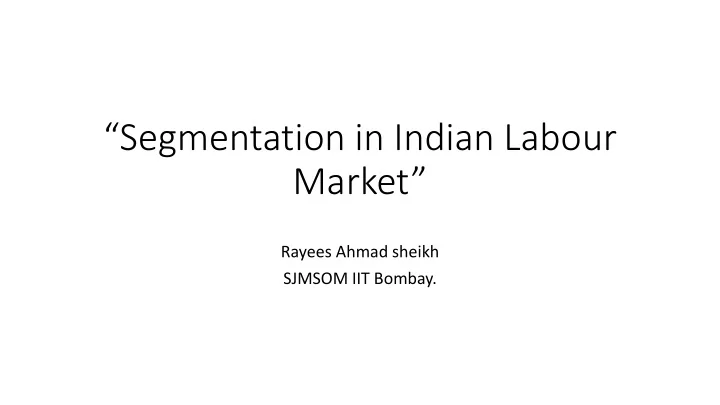

“Segmentation in Indian Labour Market” Rayees Ahmad sheikh SJMSOM IIT Bombay.
Outline • Introduction • Literature Review • Methodology • Results • Conclusion
Introduction • Majority of employment in developing countries is in informal sector - 80 percent in India (NCEUS, 2008) • Informal Sector characterized by: - Lower Wages - Lesser taxes - Low Productivity Therefore, there is wide wage gap between formal and informal sector.
Introduction • What explains the wage Gap? - Segmentation in Market - Competitive Markets • Or Is working in informal sector a voulantary choice or last resort to escape unemployment?
Introduction • Heterogeneity in informal sector is unobserved? • Studies in India have treated heterogeneity as observable? (Neog and Sahoo, 2018 , Abraham, 2018, Narayanan, 2016) • Does Job categorization mean heterogeneity ?
Motivation • India is employed in informal sector (NCEUS,2008). • Why informal sector is growing in India despite economic growth? • Informal sector and goal of sustainable growth and poverty reduction
Literature Review • developing countries have large informal sector (Pradhan & Soest, 1995 ; La Porta & Schleifer, 2014) • Informal sector size reduces with economic growth (Harris & Todaro, 1970) • Informal Sector has low wages • There exist barriers to formal sector (Reich et al. ,1973 ; Flanagan, 2008)
Literature Review • Segmentation or Competitive ? (Maloney, 1999 & Narayanan, 2015 , Pratap & Quintin, 2006) • Informal Sector is heterogeneous (Fields, 2005 ; Pratap & Quintin, 2006; Gunther & Launov, 2012) • Heterogeneity is unobservable (Pratap & Quintin, 2006; Gunther & Launov, 2012) • Some empirical studies in India have treated informal sector as homogenous (Neog & Sahoo, 2017 ; Abraham, 2017)
Methodology • Finite Mixture Model • Wages of individual “ i ” in sector “j” = + ' lny ij x u i j ij ij u • Where error term follows normal distribution • Informal sector poised is voluntarily choice, therefore = + ' y is z u i is
FMM …. Continued… • The error terms of wage equation and selection equation are assumed to follow bivariate normal distribution − + − ' ' ' ((lny ) / ) ( / )[lny ] x z x = ij i j j i j j ij i j (y | y 0) ( ) f ij is ' − ( ) z 2 1 j i j
Wage Distribution in sector • As informal sector has unobservable heterogeneity , the wage distribution of segment j J = (y ) (y | y 0, ) f f ij j ij is j = 1 j
Voluntary Choice or entry barrier ? • Maximization function if workers are assumed as wage maximizers, = = max (i Y ) P(E[lny | 0; ] {E[lny | 0; }) P y x y x j ij is i il is i ,l (1,J) I
Data • NSSO 68 th round Survey
Summary Statistics
Summary Statistics • Tables or Major Statistics
Results Table 4: Akaike's information criterion and Bayesian information criterion Model Observations df AIC BIC fmm1 17,161 19 28867.5 29014.7 fmm2 17,161 39 28063.2 28365.5 fmm3 17,161 59 26937.2 27394.5
Segmentation
Results: Voluntary Choice or entr try barrier restriction? Table 7: Last resort or voluntary choice Predicted Posterior Linear Prediction Probability Formal 0.241 0.362 Sector IF Segment 1 0.062 0.04 IF Segment 2 0.354 0.195 IF Segment 3 0.343 0.403
Conclusions • Segmentation- Informal Sector is heterogeneous • Different Wage equation in each segment of informal sector • Voluntarily Choice in upper segment
References • Fields, G. S. (2005). A welfare economic analysis of labor market policies in the Harris – Todaro model. Journal of Development Economics , 76 (1), 127-146. • Günther, I., & Launov, A. (2012). Informal employment in developing countries: Opportunity or last resort?. Journal of Development Economics , 97 (1), 88-98. • Harris, J. R., & Todaro, M. P. (1970). Migration, unemployment and development: a twosector analysis. The American Economic Review, 60(1), 126-142. • Narayanan, A. (2015). Informal employment in India: Voluntary choice or a result of labor market segmentation? Indian Journal of Labour Economics , 58 (1), 119 – 167. • • National Commission for Enterprises in the Unorganised Sector (NCEUS). (2008). Report on conditions of work and promotion of livelihoods in the unorganised sector , New Delhi. http://archive.indianstatistics.org/nceus/nceus_statistical_issues.pdf • Sahoo, B. K., & Neog, B. J. (2017). Heterogeneity and participation in informal employment among non-cultivator workers in India. International Review of Applied Economics , 31 (4), 437-467. • Pratap, S., & Quintin, E. (2006). Are labor markets segmented in developing countries? A semiparametric approach. European Economic Review, 50(7), 1817-1841. •
• Thank You
Recommend
More recommend